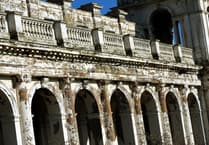A QUEST to find Teignmouth's long-lost sea defences is resting on a painting more than 150 years old. Historian John Silverman, of Higher Brimley, has been researching the fortunes of the seafront and seaward forts and batteries for more than three years. Centuries-old documents, maps and reports have led to some interesting discoveries that places Teignmouth firmly within Great Britain's maritime history. Research indicates that, in the early 1700s, fear of a French invasion was universal. With the 1690 battle still fresh in minds, a petition in 1744 to build a fort was supported by community leaders and businessmen. The fort was still there in 1759 but by 1762, maps suggest that the town was defenceless and by 1765, the fort lay in ruins. But the American war of Independence, with French support for the Americans, led to some non-royalist activity in Great Britain and spurred Teignmouth to swear allegiance to the throne. Businessman Robert Jordan headed a campaign for the reinstatement of sea defences for the port. It was built in 1794 and was staffed by volunteer artillery. But cost-cutting by the Prince Regent in the early 1800s disbanded the volunteers. As building work started on the Den and Teignmouth rose as a tourist destination for the upper classes, so the location of this fort became lost in time. Grand buildings of Den Crescent and Powderham Terrace looked out on to the newly-created Den and a seawall constructed to protect the Regency town. It seems that the genteel folk no longer wanted to look out on an aging fort and when disagreements again rose with France, the defence was moved in the 1860s, with a bigger and better artillery, towards the seafront, where the former underground loos near the disused paddling pool are today. Mr Silverman is convinced that the shape and size of the site testifies to its former use. 'I always used to wonder why the now closed loos were underground, and now I believe they were housed in the magazine of the fort, I can think of no other explanation,' he said. But what of the earlier fort, built in 1794? Mr Silverman has painstakingly mapped out the possible site, using geographical features as an indicator. 'I am of the opinion that it is below the children's playground,' he said. 'The grassy hillock and dip does seem to correlate with my research.' But further proof lies in a painting that has so far eluded the committed enthusiast. He learned of its existence in an archive copy of this newspaper. According to a report of 1851, or 1861, a painting that was exhibited in a shop in Bitton Street depicts a battery of artillery in action at the Fort on the Den. Sir Warwick Tonkin is depicted as head of command. Investigations about the picture have so far drawn a blank, but Mr Silverman is convinced it still exists. 'Where is that painting?' said Mr Silverman. 'It should provide the location of the fort I am looking for. It is the final clue to this mystery and may just solve it,' he said. Mr Silverman would also like to hear from anyone who may have information or relics from the fort.



